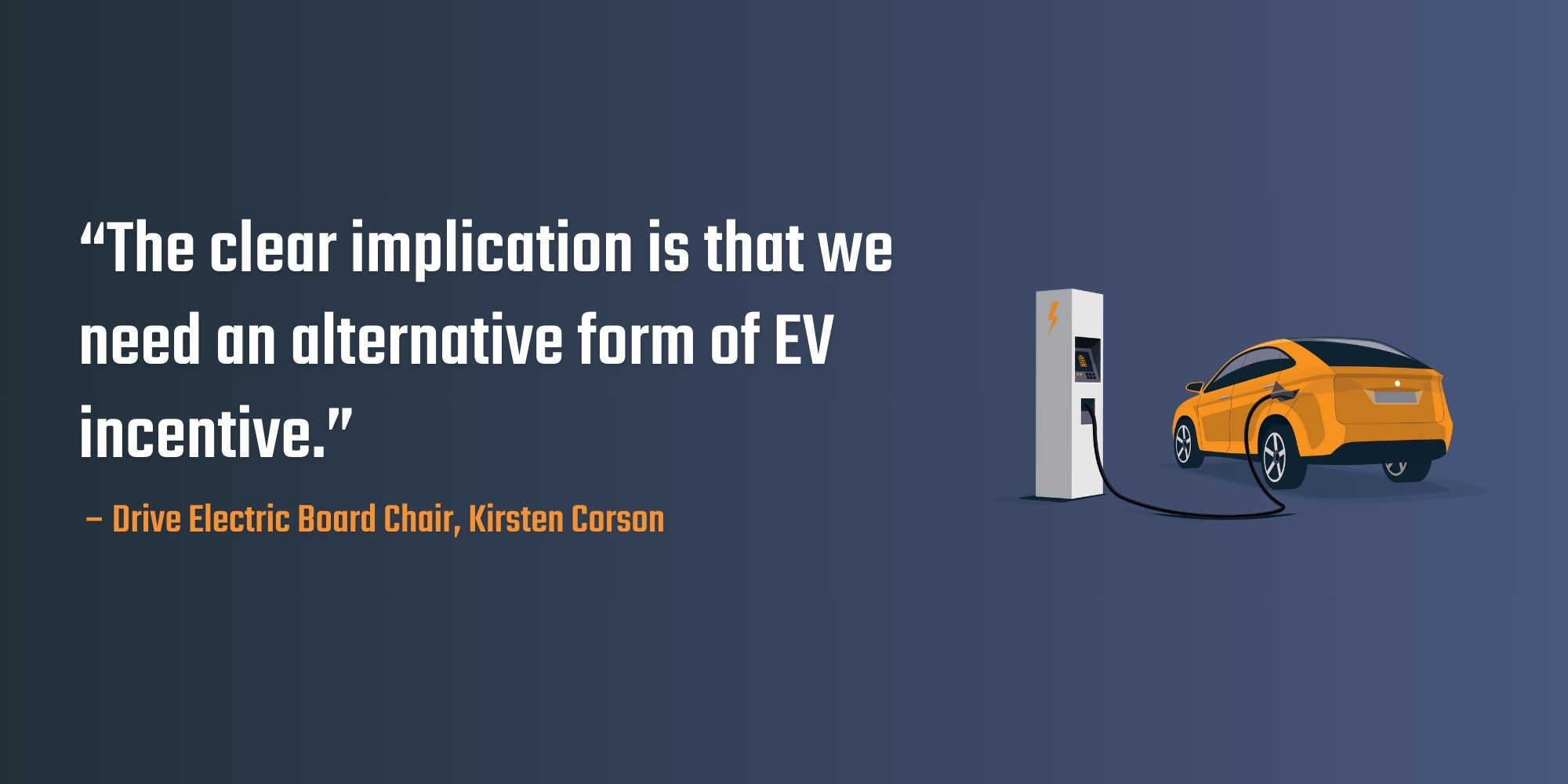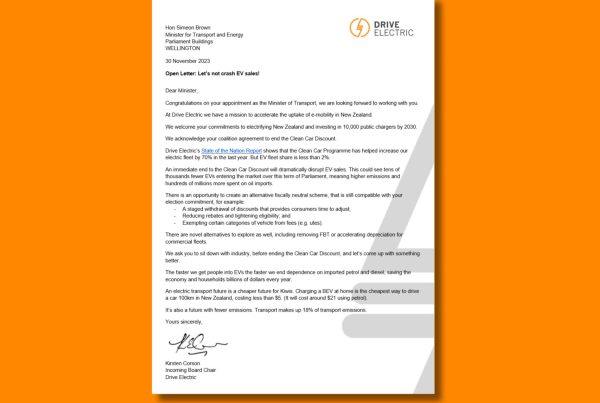Press release
13 December 2023
New research shows the new Government’s policy to remove the Clean Car Discount (CCD) and weaken the Clean Car Standard could mean between 100,000 and 350,000 fewer electric cars on New Zealand roads by 2030, and increasing emissions by between 900 and 3,000 kilotonnes. It could also increase costs to the economy by between $900m and $3.5b, mainly from importing more fossil fuel.

Drive Electric, a not-for-profit with a mission to accelerate the uptake of e-mobility in Aotearoa New Zealand, has released research demonstrating the need for EV incentives to maintain rates of EV uptake out to 2030 to save the economy money and increase emissions reductions, as Parliament prepares to consider legislation to repeal the Clean Car Discount.
Drive Electric Board Chair, Kirsten Corson says, “We understand the new Government intends to remove the Clean Car Discount by 31 December 2023. What this research shows is that there are costs associated with doing so, both to the economy and to emissions. The clear implication is that we need an alternative form of EV incentive.
“A new ICE vehicle bought today will stay on roads for 20 years consuming costly oil and releasing emissions. Cumulatively, this research is telling us this will cost the economy at least $900m and probably more, and make it much harder to hit our 2030 emissions targets.
“Without EV incentives, the carbon price will need to be higher to hit New Zealand’s emissions targets. This increases costs to households in terms of energy bills, and could result in more sheep and beef farms being converted to forestry to offset those emissions.
“EV incentives are simply an effective and comparatively cost-effective way to reduce emissions from transport. And they won’t be needed forever. As soon as EVs reach upfront price parity, they can be removed.
“This view is supported by the Climate Change Commission in its advice on ERP2, released yesterday, which says that: ‘Continued policy support is essential to encourage the purchase of new EVs at the pace needed to achieve the second and third emissions budgets. Supports to address the upfront cost barrier are especially important.’
“There are a range of different options we could consider here in New Zealand to create a fiscally neutral EV incentives scheme to encourage New Zealanders into EVs. These include adjustments such as:
- A staged withdrawal of discounts that provides consumers time to adjust;
- Reducing rebates and tightening eligibility; and
- Exempting certain categories of vehicle from fees (e.g. utes).
“There are other options too, including removing FBT and accelerating depreciation for commercial fleets. Businesses buy 50-60% of new vehicles (and 60% of new EVs), and usually only keep them in their fleets for two to five years. This could be a great source of second hand vehicles. This model is being used in Australia, and so far is proving to be successful.
“We know the Government wants to electrify New Zealand, and intends to invest in public charging. This is essential work. However, we’re also going to need to accelerate demand for EVs to take full economic advantage of electrification. We are working with industry right now on solutions to EV incentives and look forward to discussing these with the Government.”
Findings of the research
The research was undertaken by Concept Consulting, using its whole of the economy model, ENZ. The Government has indicated that it intends to adjust (weaken) the Clean Car Standard, but details of this have not yet been announced. As such, two scenarios were modelled to represent the range of possible impacts from the effect of removing the Clean Car Discount and retained the Clean Car Standard unchanged to removing the entire Clean
Car Programme.
● If only the Clean Car Discount is removed, and the Clean Car Standard stays in its current form, depending on the responses from car importers:
- There would be approximately 100,000 fewer EVs on the road by 2030.
- The reduced rates of EV uptake will increase non-emissions economic costs to the economy (mainly petrol and diesel) by at least $900m.
- The cumulative emissions associated with increased ICE travel would
increase by at least 0.9 MtCO2e out to 2030.
● If the entire Clean Car Programme (Clean Car Discount and Clean Car Standard) is removed:
- It could result in as many as 350,000 fewer EVs (PHEVs and BEVs) being on the road by 2030.
- The reduced rates of EV uptake will increase non-emissions economic costs to the economy (mainly petrol and diesel) by $2.7 billion in present value terms, rising to $3.5 billion if the increased emissions are valued using Treasury’s recommended shadow carbon price.
- The cumulative emissions associated with increased ICE travel could increase to 3.0 MtCO2e out to 2030.
[ENDS]

![[Press Release] The compelling case for EV incentives](https://driveelectric.org.nz/wp-content/uploads/2021/12/light-blue-bg.jpg)



